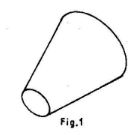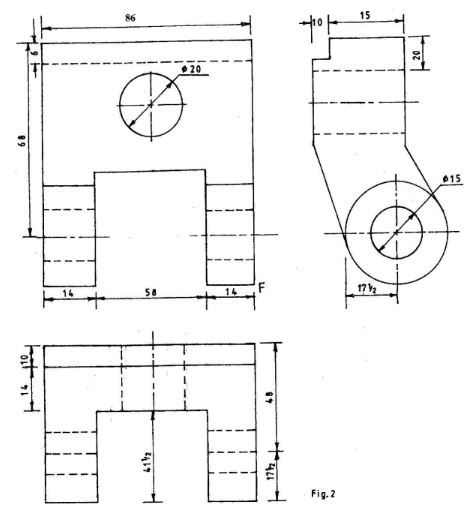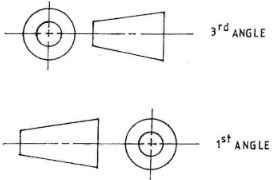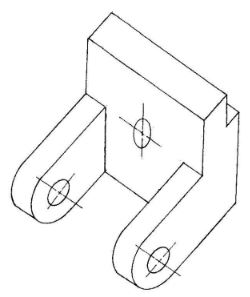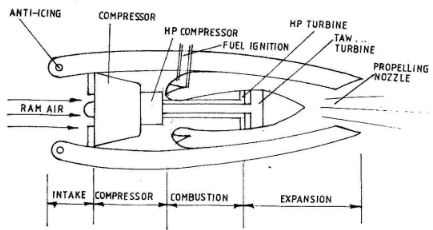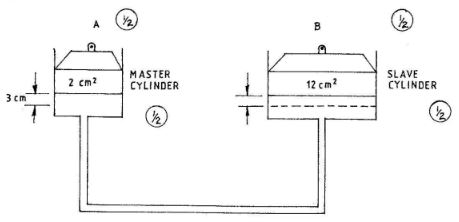Aviation Technology Paper 1 (450/1)
SECTION A (40 marks)
Answer all the questions in this section.
- List four resources considered when planning to carry out a safe maintenance task on an aircraft.(2 marks)
- State three reasons for alloying metals.(3 marks)
-
- State the use of each of the following tools:
- oddleg calipers;
- diamond chisel;
- plug gauge;
- dial test gauge.(2 marks)
- List four methods of joining metals in an aircraft.(2 marks)
- State the use of each of the following tools:
-
- State the meaning of the term meteorology as applied to aviation industry.(1 mark)
- Explain two types of information provided by the meteorology department.(2 marks)
- Sketch and state the use of each of the following aircraft hardware:
- stud;
- turnbuckle.(3 marks)
-
- Describe the behaviour of a totally stable aircraft.(1 1/2 marks)
- Give two reasons why aircrafts are not designed to enhance total stability.(2 marks)
- Explain two design features which promote lateral stability.(2 marks)
- Describe the basic construction members of an aircraft wing.(4 marks)
- Sketch and name four types of aeropiston engine cylinder arrangements.(6 marks)
- Explain five requirements of a basic electrical system.(5 marks)
-
- Draw the symbols for each of the following:
- transformer;
- diameter;
- internal threads.
- Figure 1 shows an isometric view of a truncated cone.
Draw the front and end elevation of the cone in:- first angle orthographic projection;
- third angle orthographic projection.(3 marks)
- Draw the symbols for each of the following:
SECTION B (60 marks)
Answer question 11 and any other three questions from this section.
Candidates are advised to spend not more than 25 minutes on question 11.
- Figure 2 shows the three orthographic views of a bracket drawn in first angle projection.
Draw in good proportion, an isometric view of the bracket taking F as the lowest point.(15 marks) - With the aid of a sketch, explain the operation of a twin spool turbo jet engine.(15 marks)
-
- With the aid of sketches, explain how each of the following flaps functions:
- plain;
- fowler;
- slotted.(6 marks)
- With the aid of labelled sketches, explain how a normal shock wave is formed on an aircraft within the transonic range.(9 marks)
- With the aid of sketches, explain how each of the following flaps functions:
-
- Explain four functions of hydraulic system accumulator.(4 marks)
- State the principle applied in the transmission of power in fluids.(2 marks)
- A hydraulic system has two pistons A and B with diameter 2 cm and 12 cm respectively.
- Sketch the arrangement and determine the distance moved by B when A moves 3 cm.
- Explain why the system is used in an aircraft hydraulic system.(9 marks)
-
- Explain five properties that make aluminium based alloy most suited for the construction of an aircraft fuselage.(5 marks)
- Describe each of the following maintenance tasks:
- non-destructive testing;
- on condition monitoring;
- random testing;
- destructive testing.(4 marks)
- Outline the procedure of carrying out the following methods of testing aircraft parts.
- X-Ray
- Fluorescent(6 marks)
MARKING SCHEME
- RESOURCES
- Skilled personnel.
- Tools, equipment and spares.
- Documentation, information manuals.
- Time.
- Facilities like hangar.
any (4 x 1/2)
- REASONS FOR ALLOYING
- Improve mechanical properties.
- Improve chemical properties.
- Improve physical properties.
- Make them corrosive resistant.
- Make them heat treatable.
any (3 x 1)
-
- TOOLS
- Oddleg calipers - determine centre of round bar and draw lines parallel to an edge.
- Diamond chisel - cutting very sharp corners.
- Plug gauge - checking hole limits.
- Dial gauge - determining out-of-roundness.
(4 x 1/2)
- JOINING METALS
- Soft soldering
- Brazing
- Welding
- Riveting
- Bonding
any (4 x 1/2)
- TOOLS
-
- METEOROLOGY is the science of predicting or forecasting weather for flight planning.(1 mark)
- TYPES OF INFORMATION
- Wind velocity and direction.
- Pressure for setting instruments.
- Weather: clouds and visibility
- Temperature of the aerodrome.
any (2 x 1)
-
- Stud
(Diagram missing)
for assembling two thick parts e.g engine block and cylinder head. - Turnbuckle
(Diagram missing)
for tensioning cables.
Sketches (2 x 1)
Use (2 x 1/2)
- Stud
-
- TOTALLY STABLE AIRCRAFT
An aircraft which when disturbed will return to normal without the intervention of the pilot.
(1 1/2 marks) - REASONS FOR DESIGN
- If too stable it becomes difficult to control.
- tends to be sluggish when manoeuvring.
- can become unpleasant to fly in bumpy weather.
- incase of instability, the pilot has to continually watch the aircraft attitude and constantly normalize it.
(Any 2 x 1 = 2 marks)
- DESIGN FEATURES
- Placing the wings as high as possible above the centre of gravity to provide pendulum stability.
- Placing dehedral on low wing monoplenes to prevent side slip.
- Provide swept back wing format to level the aircraft.
- Provide anhedral where wing are angled downward to prevent side slip.
(Any 2 x 1= 2 marks)
- TOTALLY STABLE AIRCRAFT
- MEMBERS OF AIRCRAFT WING.
- Spars - extend lengthwise of the wing and take the entire load carried by the wing.
- Stringers/Stiffeners - Strengthen the spars and join the ribs together.
- Stress skin - takes the force of the air acting against the flight and transmits it to the ribs and the spars.
- Ribs - support the skin and provides the aerofoil shape.
(4 x 1 = 4 marks)
- CYLINDER ARRANGEMENT.
INLINE - BASIC ELECTRICAL SYSTEM
- Power source for supply of power e.g. generator or battery.
- Power regulator/controls/switches
- Power distribution - busbars.
- Load
- Power protection/feedback - warning system
- Emergency.
any (5 x 1)
-
- SYMBOLS
-
-
- SYMBOLS
-
Faces (7 x 1) 8
Isometric Projection = 1/2
Isometric Circles 3 x 2=6
Accuracy = 1
Neatness 1/2
Total = 15 -
Sketch = 3 marks
Labelling parts = 2 marks
Labelling stages = 2 marks
EXPLANATION
Air is induced from the atmosphere by both ram effect and induction of the compressors.
INTAKE
On reaching the intake the air is heated by either hot bleed air or heated elements for the purpose of anti-icing. The air passes inlet guide vanes where the angle of attack is corrected and also further heated for prevention of icing.(2 marks)
COMPRESSION
On leaving the intake the air is passed through stages of rotors and stators of the low pressure compressor to raise the pressure energy. The air is then passed through stages of rotors and stators of the low pressure compressor to raise the pressure energy. The air is then passed through stages of rotors and stator to raise the pressure energy to the required value.(2 marks)
COMBUSTION
On leaving the compressor the high pressure air is apportioned in the following manner. 10% of the total air for mixing with air and ignited for combustion.
18% of the total air for completing combustion and shaping the flame.
72% of the total air for dilution/cooling.(2 marks)
EXPANSION
On leaving the combustion chambers the high pressure expanding gases pass through the Nozzle guide vanes which corrects the angle and also lowers the temperature.
The expanding gases impart torque on the turbine to rotate the compressors and the accessory gear box. On leaving the turbines the expanding gases has some energy left to accelerate it through propelling nozzle to generate thrust.(2 marks) -
-
- Plain Flap - This is the type of flat that increases the camber when lowered to increase the coefficient of lift at slow speeds during take off and landing. When lowered fully creates drag to decelerate the aircraft.
- Fowler Flap - This type of flap increases the wing surface area to increase the generated lift at slow speeds during take off and landing. When lowered fully it creates drags to decelerate the aircraft.
- Slotted Flap - This type of flat creates a slot when lowered to hold down the boundary layer to generate more lift during take off and landing. When lowered fully creates drag to decelerate the aircraft.(3 x 2 = 6 marks)
- Plain Flap - This is the type of flat that increases the camber when lowered to increase the coefficient of lift at slow speeds during take off and landing. When lowered fully creates drag to decelerate the aircraft.
-
- When an aircraft wing is moving below the critical mach number there is no shock wave formed. (1 mark)
- When the aircraft wing moves at critical mach number an uncipient shock wave forms at the maximum camber and starts the transonic.(1 mark)
- When the aircraft wings moves at a higher speed the top camber becomes more developed and moves 1 backwards. Also another uncipient shock wave forms at the bottom. (1 mark)
- On increasing the speed of the aircraft further the two waves become developed and moves backwards and makes the end of the transonic range. (2 marks)
- When an aircraft wing is moving below the critical mach number there is no shock wave formed. (1 mark)
-
-
- PASCAL'S LAW
- In power transmission in a closed container.
"Pressure in an enclosed container 1/2 is transmitted equally and undiminished 1/2 to all parts of the container and acts at right angles 1/2 to the enclosing walls according to Pascal's Law 12. (4 x 1/2= 2 marks) -
Volume of fluid displaced in A- volume of fluid received in B.(1)
AA(1) x LA = AB x LB(1)
πDA2 X LA= πDB2 X LB
4 4
π X 22 x 3= π x 122 x LB
4
π X 22 x 3 X 4 = LB
4 π X 122
LB = 0.0833cm - The distance moved by effort is bigger than the distance moved by load.
The load (output) is far much bigger than the effort (input) depending on the piston diameters,(2 x 1)
- In power transmission in a closed container.
- PASCAL'S LAW
-
-
- Corrosion resistance - when aluminium corrodes it forms an oxide known as alclad that prevents any further corrosion.
- Light in weight - SG is about that of iron or steel.
- Conductivity - Aluminium is a good conductor of heat and electric current electricity
- Maleability - Aluminium can be rolled into thin sheets without rupture for the construction of aircraft stressed skin.
- Ductility - Aluminium can be drawn into thin wires without fracture for the construction of cables.
- Strength to weight ratio - aluminium is very strong for the same cross sectional area of other metals.
- Machineability - Aluminium is cheap to manufacture such as casting, drop forging, cutting etc.
(Any 5x1 marks) - It can be soldered, brazed and welded.
-
- Non - Destructive testing is a means of checking the serviceability of an aircraft or engine part without causing any harm to the part.(1 mark)
- On condition monitoring is a means of checking the serviceability of an aircraft component Insitu/without removing from aircraft to prevent inflight shut-down.(1 mark)
- Batch/Random testing is a means of determining the performance of aircraft parts by peaking on item on line production and testing it to destruction on the assumption that the rest in the line production will behave in the same manner.(1 mark)
- Destructive testing is where a specimen is tested to failure on the assumption that the part to be used on the aircraft will behave in the same manner.(1 mark)
-
- X-RAY
- Evacuate the personnel.
- Encircle the area with red rotating beacons.
- Position the tranducer and the sensitive film.
- Wear protective clothing.
- Use remote switch to operate.
- Take the film to a dark room.
- View with powerful light.
- Evaluate.
Any (6 x 1/2 ) = 3 marks)
- FLUORESCENT
- Clean the part to be inspected.
- Apply the penetrant.
- Clean the part.
- Dry the part,
- Put the component into a darkroom.
- View with a fluorescent light.
- Evaluate.
Any (6 x 1/2= 3 marks)
- X-RAY
-
Download KCSE 2011 Aviation Technology Paper 1 Questions with Marking Scheme.
Tap Here to Download for 50/-
Get on WhatsApp for 50/-
Why download?
- ✔ To read offline at any time.
- ✔ To Print at your convenience
- ✔ Share Easily with Friends / Students

